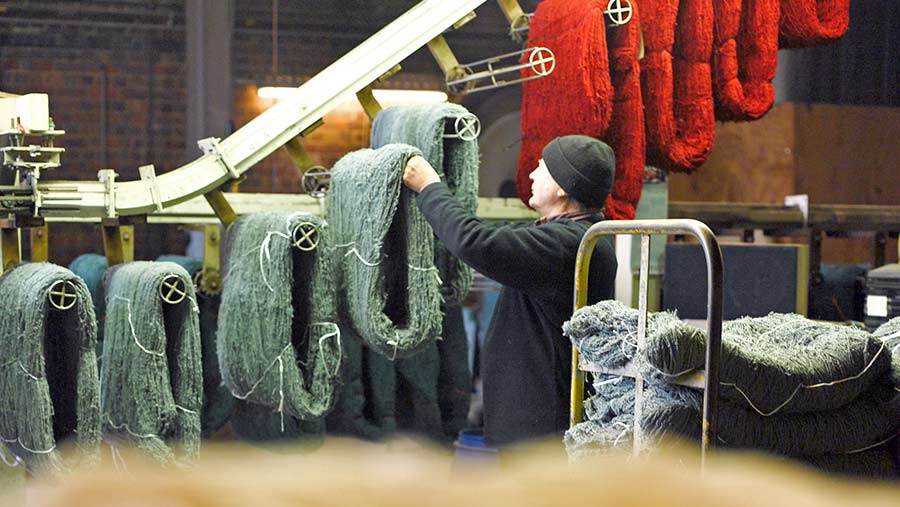Wool’s environmental credentials could open new markets

The news has been full of “plastics in the sea” stories recently and a huge contributor to this pollution are the fibres washed out of synthetic clothing by domestic washing machines.
As environmentally conscious consumers increasingly question their use of plastic and man-made fibres, this could bring new demand for British wool for both traditional and some surprising new uses.
See also: Guide to key cross-compliance dates 2018
While carpets, clothing and knitted goods still account for more than 80% of British wool, new applications are being researched and developed which could bring large scale demand for industrial uses as the life cycle impact of materials takes a higher profile.
Versatile and environmentally-friendly
Wool has the potential to score higher than man-made materials when the use of natural resources, greenhouse gas (GHG) emissions and other environmental impacts are assessed over the lifespan of a product.
As a natural polymer, wool offers the potential to replace some synthetic materials derived from oil. For example, wool is already being incorporated into polypropylene composite sheets to make them more fire retardant. It is also used to reinforce resin plastics.
Wool fibre could replace glass in high-value circuit boards where weight is an issue, according to New Zealand’s wool research board. Also in New Zealand, wool is being used to develop filters in personal protection breathing equipment.
Carpet manufacture
More than half of the 20,000t of British wool produced every year goes into carpet manufacture. This market was severely challenged by the move to laminate flooring in the 1990s and more recently by luxury vinyl tiles, in both cases especially for hallways, say carpet manufacturers.
Few carpet makers use exclusively British wool, often adding a proportion of finer and paler New Zealand fibre, which takes dye more easily.
Worcestershire-based Adam Carpets is moving to using a higher proportion of British wool and from specific sheep breeds.
Half of the company’s ranges are 100% British wool and sales director Eamonn Prescott estimates that the company’s current use is more than 75% British wool with the remainder supplied from New Zealand.
While there has traditionally been a generational transfer of the idea that a wool carpet is a worthwhile long-term investment, there is a challenge for carpet manufacturers to convince today’s younger consumers of this, says Mr Prescott.
“I’m not sure my generation has impressed this upon their children,” he says.
The company is careful to ensure waste is minimised so ends of rolls and offcuts are sold to a steel tube manufacturer and used to line and protect the tubes in transport. Any waste or surplus yarn is supplied to another manufacturer for use in premium mattresses.
Benefits of wool
- Effective all-weather protection
- Renewable and environmentally friendly
- Biodegradable
- Efficient insulator
- Very breathable
- Tough and elastic
- Easy to dye
- Low allergy likelihood
- Naturally flame-retardant, with a far higher ignition threshold than many other fibres, will not melt and stick to the skin causing burns, and produces less noxious fumes than many synthetic materials.
- Better UV protection than many synthetic fibres
Where does British wool go?
- Carpets 55%
- Knitwear and hand knitting 23%
- Clothing 8%
- Bedding 8%
- Other uses eg insulation 6%
The shares of these uses have changed relatively little in recent years, according to British Wool.
Uses for wool
- Insulation – wool has a higher R value (thermal resistance) than many other materials
- Packaging – to insulate food and pharmaceutical delivery boxes – wool can be twice as efficient as poly-based insulating materials
- Lanolin – used in sticky tape, ink and motor oils
- Building – wool is widely used as building insulation but British and Spanish universities have also used wool alongside a material found in seaweed to make clay bricks stronger. Wool is also used as a soil erosion barrier in some countries
- Cosmetics and pharmaceutical products eg lipsticks, mascara, shampoo, hair conditioners
- Wool fibres are also used in tennis ball covers, pool table baize and hanging basket liners.
- Car parts – insulation of car and other vehicle panels
- Noise absorber in industrial use, heavy machinery, speakers
- Garden mulch pads – environmentally friendly, biodegradable and high in nitrogen
- Body armour – Researchers in Australia have blended wool and Kevlar to produce lighter, cheaper and more efficient body armour than Kevlar on its own in damp conditions.
- Oil spills – wool pads are used to soak up oil
- Other uses include funeral caskets, piano hammers, tennis balls, pool table baize, hanging basket liners, pond filters
Wool market update
The world market is currently suffering from a hangover of large New Zealand stocks. Prices at the latest British Wool sale averaged 102p/kg, compared with an average of 108p/kg through last season and a range of 115p-120p/kg over the previous three to four years.
British Wool’s wool sale manager Stephen Spencer said that there was still a lot of untapped potential in the carpet market, with Chinese interest in quality British wool. However, the Chinese apparel market had recently seen a switch to finer wools such as Merino.
Wool world
The world produces about 1.16m tonnes of wool a year, with Australia by far the largest producer with 276,803t a year, followed by China (179,535t) the Commonwealth of Independent States, made up of Russia and eight other former Soviet republics, (123,312t) and New Zealand (114,893t).
